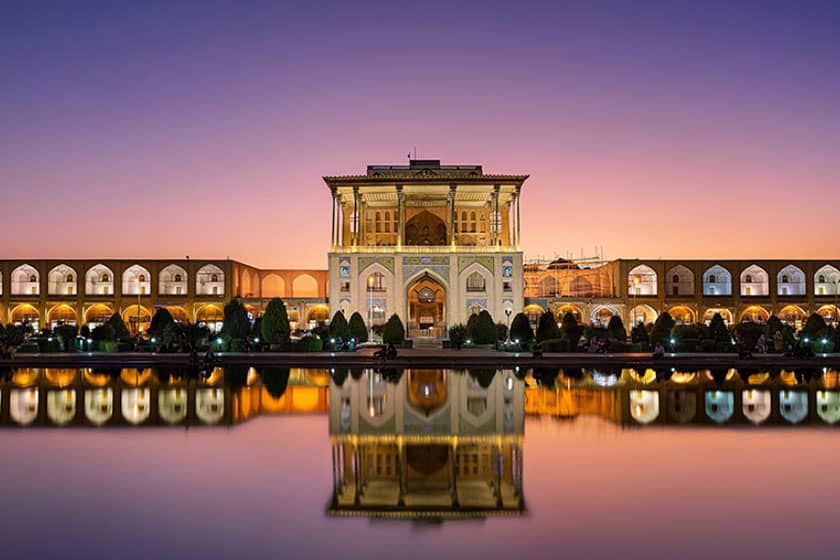
Kãkh-e Ãli Qãpou
Ali Qapu is a grand palace in Isfahan, Iran. It is located on the western side of the Naqsh e Jahan Square, opposite to Sheikh Lotfollah Mosque, and had been originally designed as a vast portal. It is forty-eight meters high and there are six floors, each accessible by a difficult spiral staircase. In the sixth floor, Music Hall, deep circular niches are found in the walls, having not only aesthetic value, but also acoustic.
The name Ali Qapu, from Persian ‘Ālī (meaning “”imperial”” or “”great””), and Azerbaijani Qāpū (meaning “”gate””), was given to this place as it was right at the entrance to the Safavid palaces which stretched from the Naqsh e Jahan Square to the Chahar Baq Boulevard. The building, another wonderful Safavid edifice, was built by decree of Shah Abbas I in the early seventeenth century. It was here that the great monarch used to entertain noble visitors, and foreign ambassadors. Shah Abbas, here for the first time, celebrated the Nowruz (Iranian New Year) of 1006 AH / 1597 C.E.
Ali Qapu is rich in naturalistic wall paintings by Reza Abbasi, the court painter of Shah Abbas I, and his pupils. There are floral, animal, and bird motifs in his works. The highly ornamented doors and windows of the palace have almost all been pillaged at times of social anarchy. Only one window on the third floor has escaped the ravages of time. Ali Qapu was repaired and restored substantially during the reign of Shah Sultan Hussein, the last Safavid ruler, but fell into a dreadful state of dilapidation again during the short reign of invading Afghans. Under the reign of Nasir ol Din Shah e Qajar (1848–96), the Safavid cornices and floral tiles above the portal were replaced by tiles bearing inscriptions.
Shah Abbas II was enthusiastic about the embellishment and perfection of Ali Qapu. His chief contribution was given to the magnificent hall, the constructures on the third floor. The 18 columns of the hall are covered with mirrors and its ceiling is decorated with great paintings.
The chancellery was stationed on the first floor. On the sixth, the royal reception and banquets were held. The largest rooms are found on this floor. The stucco decoration of the banquet hall abounds in motif of various vessels and cups. The sixth floor was popularly called the Music Hall. Here various ensembles performed music and sang songs.
From the upper galleries, the Safavid ruler watched Chowgan (polo), maneuvers and the horse-racing opposite the square of Naqsh e Jahan.
The palace is depicted on the reverse of the Iranian 20,000 rials banknote. Actually, the palace is depicted on the reverse of the Iranian 20 rials banknote series 1953.

The stunning Ali Qapu Palace is one of the most significant architectural heritage of Iran, which was built in Isfahan during the Safavid Dynasty in Isfahan. This construction is located on the west side of the royal Naqsh-e Jahan Square which is the second biggest historical square in the world and is inscribed as a UNESCO World Heritage Site because of its cultural and historical importance. The name of Ali Qapu is an Azeri word which means “The Excellent Gate” and was used as the residence of the Safavid kings and the royal palace for official meetings.
So while visiting the gorgeous city of Isfahan, do not forget to visit the Ali Qapu Palace which is one of the must-see attractions of this city.
There are two sets of staircases to the top floor. Staircases are very narrow only one Person can climb the stairs at the same time. On the west side of the fifth floor, there is a balcony facing to royal gardens, and the palace of Chehel Sotoun. Just on western side in the same neighborhood there is an old monument, called Tohid Khaneh. It was used by Dervishes at the time of Shah Abbas the great. This monument and all rooms enclosed the Tohid Khane’s courtyard, now are used as a part of the Faculty of Fine Arts of Isfahan.
Unfortunately some crazy visitors have damaged lower plaster and stucco works. One of the most attractive parts of the palace is the Verandah, in the third floor. A beautiful panoramic view of the Imam square, the Seljuk old town and also Isfahan can be seen.
The verandah has 18 wooden pillars in three rows. The ceiling of verandah is a two shell roof. Inner shell is decorated with mirror, and paintings on wood. The outer shell is used as a protection shell. Originally, wooden pillars were decorated with mirror and painted inlaid wood. There is a remarkable pool in the centre of verandah made of copper plates and has fountains. For certain occasions the pool was filled with water, brought to the pool by bucket-wheel (Charkh Ab).
Water was collected from semi deep well and transferred to the pool. Beautiful certains covered three sides of verandah, when privacy needed. The royal family and their guests could watch polo games and different ceremonies from the verandah. On the west of verandah there is a magnificent throne hall decorated with fabulous plaster carvings and miniature painting.
Reza Abbasi and his team of painters have left extraordinary paintings, especially on the ceiling. The last floor of the palace is famous as the music hall. The most unique plaster work has ornamented upper parts and the ceiling. Through this plasters work different imaginary shapes, such as flower vases, dishes, plates and bottle can be seen.
Music hall’s ornamentation is a new decorative invention of Safavid era. Sad to say that in 19th century magnificent original paintings and gilded decorations were notched and destroyed and a new layer of inartistic plaster work covered original works.
The Ali Qapu palace was fundamentally restored and repaired by Iranian and Italian artists and masters. Different walls and pillars of palace have been strengthened by iron beams.
